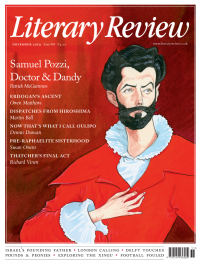Jonathan Keates
Fronte Femminile
A House in the Mountains: The Women Who Liberated Italy from Fascism
By Caroline Moorehead
Chatto & Windus 390pp £20
Like other Italian regions, Piedmont, occupying the country’s northwestern corner, has a powerful identity of its own. An area of Alpine mountains fringed with vineyards, it is dominated by the city of Turin, a capital laid out in the 17th century by the insatiably ambitious dukes of Savoy, whose descendants became kings of a united Italy. The family’s charmlessness, arrogance and overweening sense of entitlement meant that nobody save a few cranky legitimists ever yearned for its restoration after a 1946 plebiscite bundled the last scion off to early retirement in a Portuguese villa. More broadly, the Piedmontese enjoy a reputation among their fellow Italians for mixing studied politeness with fundamental dishonesty. Piemontese falso e cortese is a cliché that has never quite died.
The true grit of these Savoyard mountaineers and their readiness to make the best use of their capacity for falsehood in the cause of overcoming evil were tested by what happened to Italy in 1943. In July, following the Allied conquest of Sicily, King Victor Emmanuel III dismissed Mussolini. In October, after the Allies and Italians had agreed on an armistice, Hitler launched a military invasion, establishing the defensive Gothic Line to counter an Anglo-American thrust northwards. Italians caught behind it faced the grimmest of choices. Either you knuckled under to the Wehrmacht and the thuggish agents of Mussolini’s puppet republic centred on Lake Garda or else you joined the resistance that was rapidly forming – politically disparate groups of partisans spread across the entire occupied zone.
In A House in the Mountains, Caroline Moorehead focuses on the wartime experiences of a group of friends, four Piedmontese women who took to the mountains with the freedom fighters. Ada Gobetti was the youthful widow of a leading anti-Fascist whom Mussolini’s Blackshirts had effectively beaten to death. Frida

Sign Up to our newsletter
Receive free articles, highlights from the archive, news, details of prizes, and much more.@Lit_Review
Follow Literary Review on Twitter
Twitter Feed
The son of a notorious con man, John le Carré turned deception into an art form. Does his archive unmask the author or merely prove how well he learned to disappear?
John Phipps explores.
John Phipps - Approach & Seduction
John Phipps: Approach & Seduction - John le Carré: Tradecraft; Tradecraft: Writers on John le Carré by Federico Varese (ed)
literaryreview.co.uk
Few writers have been so eagerly mythologised as Katherine Mansfield. The short, brilliant life, the doomed love affairs, the sickly genius have together blurred the woman behind the work.
Sophie Oliver looks to Mansfield's stories for answers.
Sophie Oliver - Restless Soul
Sophie Oliver: Restless Soul - Katherine Mansfield: A Hidden Life by Gerri Kimber
literaryreview.co.uk
Literary Review is seeking an editorial intern.